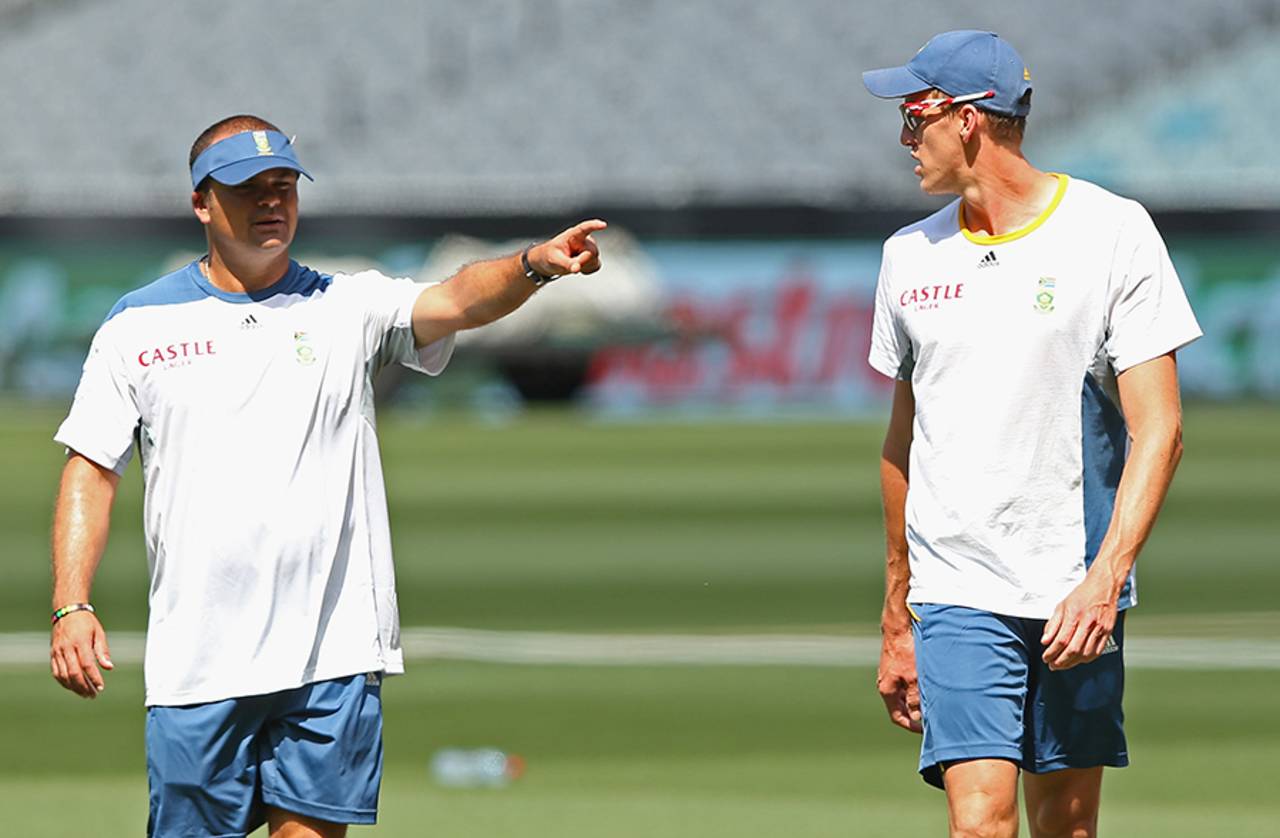Charl Langeveldt's ODI career was only 13 games old when he was tasked with a job a man of much greater experience may have found nerve-wracking. He had to defend ten runs off the final over in a
match against West Indies in Barbados; a match South Africa did not have to win but one that would seal the five-match series early for them.
Not only did Langeveldt prevent the West Indian tail from plundering the runs but he removed three of them in successive balls to finish with his first five-for and a slice of history. Eleven years later, Langeveldt, who is now South Africa's bowling coach, still remembers it vividly. "The ground has changed a lot. It was still wooden. The change rooms were on the other side. But the memory is still there," he said. On Friday, South Africa will take on West Indies at the same ground in a must-win match that will decide which team meets Australia in the tri-nation series final.
Many Bajans can still recall that over and one of them asked Langeveldt to "take me through what you thinking" on that day. Like many sportsmen who act on instinct, Langeveldt admitted he "wasn't thinking about a lot", because "as soon as you start thinking about the outcome you're not going to perform; you're not going to perform the way you want to."
Instead he eased his mind with the knowledge that the game was probably gone. "Before the last over there was hardly any pressure because we were expecting to lose the game," he said.
By the third ball of that over, the thought was justified. West Indies had already scored eight of the ten runs they needed to win. But then Langeveldt bowled Ian Bradshaw and "the pressure was on". Suddenly, he knew "we had a chance" and started to hatch his plans for the No.10 batsman, Daren Powell.
"He walked in with a cap and I thought I should bounce him because that's disrespect to a fellow fast bowler. But I also thought he's going to play with his ego, so I went full," Langeveldt explained. "But not that full because I thought if it's too full he's going to try and hit me over my head. So it was the perfect delivery."
It was. Powell was also bowled and Langeveldt realised he had a chance to be a hero. "When I saw Corey Collymore, I thought this is probably the best batsman to bowl at if you want to take a hat-trick. He's a proper tail-ender. Bowling that last ball, as soon as I delivered it, I knew it was out."
Another full, straight delivery left Langeveldt thinking he had breached Collymore's defences, when in fact he had wrapped him on the pad. "I thought he was bowled," he said. "I
got fined because it was lbw and I didn't appeal, I didn't turn around to the umpire. It was probably the most expensive hat-trick in world cricket."
Now Langeveldt's job is to hone the end-overs bowling skills of the current South African attack, whose tactics were markedly different from his until recently. When he took over as bowling coach in June last year, South Africa had all but abandoned the yorker as a last-over weapon and were experimenting with short balls instead.
Their reasoning was two-fold: short balls are their natural strength and it made sense to bowl the deliveries they were most comfortable with in pressure situations. They also believed yorkers had become predictable at the end and they were trying to be less so themselves. Regardless of the personnel putting that plan into action - be it Dale Steyn, Kyle Abbott or Wayne Parnell - it did not really work. End-overs bowling was highlighted as an issue before the 2015 World Cup and perhaps ultimately cost them a place in the final.
Since then Langeveldt has worked to bring South Africa back to the yorker. "In our one-day and T20 cricket, we were lacking in the skills department. It was a conscious decision to try and uplift our skills. It's come up in leaps and bounds. We're getting there but it's still a work in progress," he said. "Hopefully in the next few months we will get to where everyone has got a different slower ball, everyone can bowl a yorker at will, everyone can bowl a slower-ball bouncer. That's the ultimate."
Kagiso Rabada has been the best example of the progress South Africa have made, although his skills at the end have not been needed in the ongoing series in the Caribbean. Spinners have had the biggest impact so far, and most matches have been won before the dying stages, but that could change at Kensington Oval. Langeveldt is expecting a surface with some grass on it to assist the seamers and is getting them all ready to play in the must-win match.
"We're not sure who we're going to go for but we're preparing as if all the seamers are going to play," he said. "We have versatility in all areas."
South Africa have paired Rabada with Wayne Parnell and Kyle Abbott two times each in the series so far, forcing Morne Morkel to the bench until their washout against Australia on Sunday. They also have Chris Morris at their disposal, although he plays as a first-change bowler. With space for three, or at most four, of the five seamers in their XI, Langeveldt may look to the one who seems most likely to repeat his heroics.
Firdose Moonda is ESPNcricinfo's South Africa correspondent
